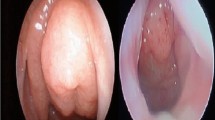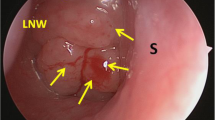Abstract
Aim is to compare coblation versus conventional adenoidectomy, to evaluate whether this approach is adequate, safer and could be a coblation a good alternative of conventional adenoidectomy? It is a prospective randomized controlled study done at Civil Hospital Ahmedabad from January 2016 to January 2017 with 70 patients. The study includes children between age groups 5–11 years divided into Group A (38 children underwent coblation adenoidectomy) and Group B (32 children underwent conventional adenoidectomy) with an average follow-up period of 10 days, 1 month and 3 months. Information on average time of operation, intra-operative blood loss, post-operative pain, and time required regaining normal breathing pattern, presence of residual adenoid tissue 4 weeks after surgery and postoperative hemorrhage were gathered and compared. We found statistically significant differences in average operation time (p < 0.001), intra-operative blood loss (p < 0.001), post-operative pain (p < 0.0001) and time required regaining normal nasal breathing pattern (p < 0.001) presence of residual adenoid tissue 4 weeks after surgery (p < 0.0001) However, post operative hemorrhage (p > 0.5) was not significantly different between two groups. This study suggested a significantly less intra-operative or postoperative complications and morbidity in coblation adenoidectomy in comparison with conventional method. Coblation was associated with less pain and quick return to normal nasal breathing pattern. These findings indicate that coblation adenoidectomy is a safer, method and can be a better alternative of conventional method.




Similar content being viewed by others
References
Gallagher TQ, Wilcox L, McGuire E et al (2010) Analyzing factors associated with major complications after adenotonsillectomy in 4776 patients: comparing three tonsillectomy techniques. Otolaryngol Head Neck Surg 142:886–892
Regmi D, Mathur NN, Bhattarai M (2011) Rigid endoscopic evaluation of conventional curettage adenoidectomy. J Laryngol Otol 125:53–58
Glade RS, Pearson SE, Zalzal GH et al (2006) Coblation adenotonsillectomy: an improvement over electrocautery technique? Otolaryngol Head Neck Surg 134:852–855
Timms MS, Ghosh S, Roper A (2005) Adenoidectomy with the coblator: a logical extension of radiofrequency tonsillectomy. J Laryngol Otol 119:398–399
Krajewski M, Samoliaski B, Schmidt J (2007) Endoscopic adenotomy—clinical assessment of value and safety—an own experience. Otolaryngol Pol 61:21–24
Songu M, Altay C, Adibelli ZH, Adibelli H (2010) Endoscopicassisted versus curettage adenoidectomy: a prospective, randomized, double-blind study with objective outcome measures. Laryngoscope 120:1895–1899
Parikh SR, Coronel M, Lee JJ, Brown SM (2006) Validation of a new grading system for endoscopic examination of adenoid hypertrophy. Otolaryngol Head Neck Surg 135:684–687
Horwitz RI, McFarlane MJ, Brennan TA et al (1985) The role of susceptibility bias in epidemiologic research. Arch Intern Med 145:909–912
Regmi D, Mathur NN, Bhattarai M (2011) Rigid endoscopic evaluation of conventional curettage adenoidectomy. J Laryngol Otol 125:53–58
Di Rienzo Businco L (2010) ORL per immagini, 1st edn. Franco Lozzi Editore, Rome, pp 97–98
Author information
Authors and Affiliations
Corresponding author
Ethics declarations
Conflict of interest
The authors declare that they have no conflict of interest.
Ethical Approval
All procedures performed in this study involving human participant were in accordance with the ethical standard.
Additional information
Publisher's Note
Springer Nature remains neutral with regard to jurisdictional claims in published maps and institutional affiliations.
Dr. Kalpesh Patel is Associate professor and Dr. Rajesh Vishwakarma is Head of the department.
Rights and permissions
About this article
Cite this article
Chauhan, V.M., Patel, K.B. & Vishwakarma, R. Plasma Dissection Versus Tissue Dissection in Adenoid Surgery. Indian J Otolaryngol Head Neck Surg 72, 156–159 (2020). https://doi.org/10.1007/s12070-019-01721-y
Received:
Accepted:
Published:
Issue Date:
DOI: https://doi.org/10.1007/s12070-019-01721-y




